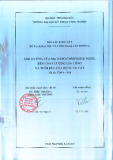
Hindawi Publishing Corporation
EURASIP Journal on Advances in Signal Processing
Volume 2011, Article ID 639043, 14 pages
doi:10.1155/2011/639043
Research Article
Novel VLSI Algorithm and Architecture with Good
Quantization Properties for a High-Throughput Area
Efficient Systolic Array Implementation of DCT
Doru Florin Chiper and Paul Ungureanu
Faculty of Electronics, Telecommunications and Information Technology, Technical University “Gh. Asachi”,
B-dul Carol I, No.11, 6600 Iasi, Romania
Correspondence should be addressed to Doru Florin Chiper, chiper@etc.tuiasi.ro
Received 31 May 2010; Revised 18 October 2010; Accepted 22 December 2010
Academic Editor: Juan A. L ´
opez
Copyright © 2011 D. F. Chiper and P. Ungureanu. This is an open access article distributed under the Creative Commons
Attribution License, which permits unrestricted use, distribution, and reproduction in any medium, provided the original work is
properly cited.
Using a specific input-restructuring sequence, a new VLSI algorithm and architecture have been derived for a high throughput
memory-based systolic array VLSI implementation of a discrete cosine transform. The proposed restructuring technique
transforms the DCT algorithm into a cycle-convolution and a pseudo-cycle convolution structure as basic computational forms.
The proposed solution has been specially designed to have good fixed-point error performances that have been exploited to
further reduce the hardware complexity and power consumption. It leads to a ROM based VLSI kernel with good quantization
properties. A parallel VLSI algorithm and architecture with a good fixed point implementation appropriate for a memory-based
implementation have been obtained. The proposed algorithm can be mapped onto two linear systolic arrays with similar length and
form. They can be further efficiently merged into a single array using an appropriate hardware sharing technique. A highly efficient
VLSI chip can be thus obtained with appealing features as good architectural topology, processing speed, hardware complexity and
I/O costs. Moreover, the proposed solution substantially reduces the hardware overhead involved by the pre-processing stage that
for short length DCT consumes an important percentage of the chip area.
1. Introduction
The discrete cosine transform (DCT) and discrete sine
transform (DST) [1–3] are key elements in many digital
signal processing applications being good approximations to
the statistically optimal Karhunen-Loeve transform [2,3].
They are used especially in speech and image transform
coding [3,4], DCT-based subband decomposition in speech
and image compression [5], or video transcoding [6].
Other important applications are: block filtering, feature
extraction [7], digital signal interpolation [8], image resizing
[9], transform-adaptive filtering [10,11], and filter banks
[12].
The choice of DCT or DST depends on the statistical
properties of the input signal. For low correlated input
signals, DST offers a lower bit rate [3]. For high correlated
input signals, DCT is a better choice.
Prime-length DCTs are critical for a prime-factor algo-
rithm (PFA) technique to implement DCT or DST. PFA
technique can be used to significantly reduce the overall
complexity [13] that results in higher-speed processing and
reduced hardware complexity. PFA can split a N=N1×N2
point DCT, where N1 and N2 are mutually primes, into a
two-dimensional N1×N2DCT. DCT is then applied for each
dimension, and the results are combined through input and
output permutations.
The DCT and DST are computationally intensive. The
general-purpose computers usually do not meet the speed
requirements for various real-time applications and also
the size and power constraints for many portable systems

2 EURASIP Journal on Advances in Signal Processing
although many efforts have been made to reduce the
computational complexity [14,15]. Thus, it is necessary
to reformulate or to find new VLSI algorithms for these
transforms. These hardware algorithms have to be designed
appropriately to meet the system requirements. To meet the
speed and power requirements, it is necessary to appropri-
ately exploit the concurrency involved in such algorithms.
Moreover, the VLSI algorithm and architecture have to be
derived in a synergetic manner [16].
The data movement into the VLSI algorithm plays an
important role in determining the efficiency of a hardware
algorithm. It is well known that FFT, which plays in
important role in the software implementation of DFT,
is not well suited for VLSI implementation. This is one
explanation why regular computational structures such as
cyclic convolution and circular correlation have been used
to obtain efficient VLSI implementations [17–19] using
modular and regular architectural paradigm as distributed
arithmetic [20]orsystolicarrays[21]. This approach leads
to low I/O cost and reduced hardware complexity, high speed
and a regular and modular hardware structure.
Systolic arrays are an appropriate architectural paradigm
that leads to efficient VLSI implementations that meet
the increased speed requirements of real-time applications
through an efficient exploitation of concurrency involved in
the algorithms. This paradigm is well suited to the character-
istics of the VLSI technology through its modular and regular
structure with local and regular interconnections.
Owing to regular and modular structure of ROMs,
memory-based techniques are more and more used in the
recent years. They offer also a low hardware complexity
and high speed for relatively small sizes compared with
the multiplier-based architectures. Multipliers in such archi-
tectures [22–25] consume a lot of silicon area, and the
advantages of the systolic array paradigm are not evident for
such architectures. Thus, memory-based techniques lead to
cost-effective and efficient VLSI implementations.
One memory-based technique is the distributed arith-
metic (DA). This technique is largely used in commercial
products due to its efficient computation of an inner-
product. It is faster then multiplier-based architecture due
to the fact that it uses precomputed partial results [26,27].
However, the ROM size increases exponentially with the
transform length, even if a lot of work have been done to
reduce its complexity as in [28], rendering this technique
impractical for large sizes. Moreover, this structure is difficult
to pipeline.
The other main technique is the direct-ROM implemen-
tation of multipliers. In this case, multipliers are replaced
with ROlM-based look-up table (LUT) of size 2Lwhere Lis
the word length. The 2Lpre-computed values of the product
for all possible values of the input are stored in the ROM.
In [16,19], another memory-based technique that
combines the advantages of the systolic arrays with those
of memory-based designs is used. This technique will be
called memory-based systolic arrays. When the systolic array
paradigm is used as a design instrument, the advantages are
evident only when a large number of processing elements can
be integrated on the same chip. Thus, it is very important to
reduce the PE chip area using small ROMs as it is proposed
in this technique.
In this paper, a new parallel VLSI algorithm for a prime-
length Discrete Cosine Transform (DCT) is proposed. It
significantly simplifies the conversion of the DCT algorithm
into a cycle and a pseudo-cycle convolution using only a new
single input restructuring sequence. It can be used to obtain
an efficient VLSI architecture using a linear memory-based
systolic array. The proposed algorithm and its associated
VLSI architecture have good numerical properties that can
be efficiently exploited to lead to a low-complexity hardware
implementation with low power consumption. It uses a
cycle and a pseudo-cycle convolution structure that can
be efficiently mapped on two linear systolic arrays having
the same form and length and using a small number
of I/O channels placed at the two extreme ends of the
array. The proposed systolic algorithm uses an appropriate
parallelization method that efficiently decomposes DCT into
a cycle and a pseudo-cycle convolution structure, obtaining
thus a high throughput. It can be efficiently computed
using two linear systolic arrays and an appropriate control
structure based on the tag-control scheme. The proposed
approach is based on an efficient parallelization scheme
and an appropriate reordering of these sequences using
the properties of the Galois Field of the indexes and the
symmetry property of the cosine transform kernel. Thus,
using the proposed algorithm, it is possible to obtain
a VLSI architecture with advantages similar to those of
systolic array and memory-based implementations using
the benefit of the cycle convolution. Thus a high speed,
low I/O cost, and reduced hardware complexity with a
high regularity and modularity can be obtained. Moreover,
the hardware overhead involved by the preprocessing stage
can be substantially reduced as compared to the solution
proposed in [16].
The paper is organized as follows. In Section 2, the
new computing algorithm for DCT encapsulated into the
memory-based systolic array is presented. In Section 3,two
examples for the particular lengths N=7andN=11
are used to illustrate the proposed algorithm. In Section 4,
aspects of the VLSI design using the memory-based systolic
array paradigm and a discussion on the effects of a finite
precision implementation are presented. In Section 5, the
quantization properties of the proposed algorithm and
architecture are analyzed analytically and by computer
simulation. In Section 6, comparisons with similar VLSI
designs are presented together with a brief discussion on the
efficiency of the proposed solution. Section 7 contains the
conclusions.
2. Systolic Algorithm for 1D DCT
For the real input sequence x(i):i=0, 1, ...,N−1, 1D DCT
is defined as
X(k)=2
N·
N−1
i=0
x(i)·cos[(2i+1
)k·α],(1)

EURASIP Journal on Advances in Signal Processing 3
for k=1, ...,N
with α=π
2N.(2)
To simplify the presentation, the constant coefficient √2/N
will be dropped from (1) that represents the definition of
DCT; a multiplier will be added at the end of the VLSI array
to scale the output sequence with this constant.
We will reformulate relation (1) as a parallel decomposi-
tion based on a cycle and a pseudo-cycle convolution forms
using a single new input restructuring sequence as opposed
to [16] where two such auxiliary input sequences were used.
Further, we will use the proprieties of DCT kernel and those
of the Galois Field of indexes to appropriately permute the
auxiliary input and output sequences.
Thus, we will introduce an auxiliary input sequence
{xa(i):i=0, 1, ...,N−1}.Itcanberecursivelydefined
as follows:
xa(N−1)=x(N−1),(3)
xa(i)=(−1)ix(i)+xa(i+1
),(4)
for i=N−2, ...,0.
Using this restructuring input sequence, we can reformu-
late (1) as follows:
X(0)=xa(0)+2
N−1
i=0
(−1)ϕ(i)
×xaϕ(i)−xaϕi+(N−1)
2,
X(k)=[xa(0)+T(k)]·cos(kα),fork=1, ...,N−1.
(5)
The new auxiliary output sequence {T(k):k=1, 2,
...,N−1}can be computed in parallel as a cycle and pseudo-
cycle convolutions if the transform length Nis a prime
number as follows:
T(δ(k)) =
(N−1)/2
i=1
(−1)ξ(k,i)
·xaϕ(i−k)−xaϕi−k+(N−1)
2
×2·cosψ(i)×2α,
Tγ(k)=
(N−1)/2
i=1
(−1)ζ(i)
·xaϕ(i−k)+xaϕi−k+(N−1)
2
×2·cosψ(i)×2αfor k=0, 1, ...,(N−1)
2,
(6)
where
ψ(k)=⎧
⎪
⎨
⎪
⎩
ϕ′(k)if ϕ′(k)≤(N−1)
2,
ϕ′(N−1+k)otherwise,
(7)
with
ϕ′(k)=⎧
⎨
⎩
ϕ(k)if k>0,
ϕ(N−1+k)otherwise
ϕ(k)=gkN,
,(8)
where xNdenotes the result of xmodulo Nand gis the
primitive root of indexes.
We have also used the properties of the Galois Field of
indexes to convert the computation of DCT as a convolution
form.
3. Examples
To illustrate our approach, we will consider two examples for
1D DCT, one with the length N=7 and the primitive root
g=3 and the other with the length N=11 and the primitive
root g=2.
3.1. DCT Algorithm with Length N=7.We recursively
compute the following input auxiliary sequence {xa(i):i=
0, ...,N−1}as follows:
xa(6)=x(6),
xa(i)=(−1)ix(i)+xa(i+1
),fori=5, ...,0.
(9)
Using the auxiliary input sequence {xa(i):i=0, ...,N−1},
we can write (6)inamatrix-vectorproductformas
⎡
⎢
⎢
⎢
⎣
T(4)
T(2)
T(6)
⎤
⎥
⎥
⎥
⎦
=⎡
⎢
⎢
⎢
⎣
−[xa(3)−xa(4)]−[xa(2)−xa(5)]−[xa(6)−xa(1)]
[xa(6)−xa(1)]xa(3)−xa(4)−[xa(2)−xa(5)]
xa(2)−xa(5)−[xa(6)−xa(1)]xa(3)−xa(4)
⎤
⎥
⎥
⎥
⎦
·⎡
⎢
⎢
⎢
⎣
c(2)
c(1)
c(3)
⎤
⎥
⎥
⎥
⎦,
(10)

4 EURASIP Journal on Advances in Signal Processing
⎡
⎢
⎢
⎢
⎣
T(3)
T(5)
T(1)
⎤
⎥
⎥
⎥
⎦
=⎡
⎢
⎢
⎢
⎣
xa(3)+xa(4)xa(2)+xa(5)xa(6)+xa(1)
xa(6)+xa(1)xa(3)+xa(4)xa(2)+xa(5)
xa(2)+xa(5)xa(6)+xa(1)xa(3)+xa(4)
⎤
⎥
⎥
⎥
⎦
·⎡
⎢
⎢
⎢
⎣
c(2)
−c(1)
−c(3)
⎤
⎥
⎥
⎥
⎦,
(11)
where we have noted c(k)for2·cos(2kα).
The index mappings δ(i)andγ(i) realize a partition into
two groups of the permutation of indexes {1, 2, 3, 4, 5, 6}.
Theyaredefinedasfollows:
{δ(i):1−→ 4, 2 −→ 2, 3 −→ 6},
γ(i):1−→ 3, 2 −→ 5, 3 −→ 1.(12)
The functions ξ(k,i)andζ(i) define the sign of terms in
(10), respectively, as follows:
ξ(k,i) is defined by the matrix 111
001
010
and
ζ(i) is defined by the vector [0 1 1].
Finally, the output sequence {X(k):k=1, 2, ...,N−1}can
be computed as
X(1)=[xa(0)+T(1)]·cos[α],
X(2)=[xa(0)+T(2)]·cos[2α],
X(3)=[xa(0)+T(3)]·cos[3α],
X(4)=[xa(0)+T(4)]·cos[4α],
X(5)=[xa(0)+T(5)]·cos[5α],
X(6)=[xa(0)+T(6)]·cos[6α],
X(0)=xa(0)+2
3
i=1
(−1)ϕ(i)
×xaϕ(i)−xaϕi+(N−1)
2.
(13)
3.2. DCT Algorithm with Length N=11.We recursively
compute the following input auxiliary sequence {xa(i):i=
0, ...,N−1}as follows:
xa(10)=x(10),
xa(i)=(−1)ix(i)+xa(i+1
)for i=9, ...,0.
(14)
Using the auxiliary input sequence {xa(i):i=0, ...,N−1}
we can write (6)inamatrix-vectorproductformas
⎡
⎢
⎢
⎢
⎢
⎢
⎢
⎢
⎢
⎢
⎢
⎢
⎢
⎣
T(2)
T(4)
T(8)
T(6)
T(10)
⎤
⎥
⎥
⎥
⎥
⎥
⎥
⎥
⎥
⎥
⎥
⎥
⎥
⎦
=
⎡
⎢
⎢
⎢
⎢
⎢
⎢
⎢
⎢
⎢
⎢
⎢
⎢
⎣
xa(2)−xa(9)−(xa(4)−xa(7)) xa(8)−xa(3)xa(5)−xa(6)xa(10)−xa(1)
xa(10)−xa(1)−(xa(2)−xa(9)) −(xa(4)−xa(7)) −(xa(8)−xa(3)) −(xa(5)−xa(6))
−xa(5)−xa(6)−(xa(10)−xa(1)) −(xa(2)−xa(9)) −(xa(4)−xa(7)) xa(8)−xa(3)
xa(8)−xa(3)xa(5)−xa(6)−(xa(10)−xa(1)) −(xa(2)−xa(9)) xa(4)−xa(7)
xa(4)−xa(7)−(xa(8)−xa(3)) xa(5)−xa(6)−(xa(10)−xa(1)) xa(2)−xa(9)
⎤
⎥
⎥
⎥
⎥
⎥
⎥
⎥
⎥
⎥
⎥
⎥
⎥
⎦
·
⎡
⎢
⎢
⎢
⎢
⎢
⎢
⎢
⎢
⎢
⎢
⎢
⎢
⎣
c(4)
c(3)
c(5)
c(1)
c(2)
⎤
⎥
⎥
⎥
⎥
⎥
⎥
⎥
⎥
⎥
⎥
⎥
⎥
⎦
,
⎡
⎢
⎢
⎢
⎢
⎢
⎢
⎢
⎢
⎢
⎢
⎢
⎢
⎣
T(9)
T(7)
T(3)
T(5)
T(1)
⎤
⎥
⎥
⎥
⎥
⎥
⎥
⎥
⎥
⎥
⎥
⎥
⎥
⎦
=
⎡
⎢
⎢
⎢
⎢
⎢
⎢
⎢
⎢
⎢
⎢
⎢
⎢
⎣
xa(2)+xa(9)xa(4)+xa(7)xa(8)+xa(3)xa(5)+xa(6)xa(10)+xa(1)
xa(10)+xa(1)xa(2)+xa(9)xa(4)+xa(7)xa(8)+xa(3)xa(5)+xa(6)
xa(5)+xa(6)xa(10)+xa(1)xa(2)+xa(9)xa(4)+xa(7)xa(8)+xa(3)
xa(8)+xa(3)xa(5)+xa(6)xa(10)+xa(1)xa(2)+xa(9)xa(4)+xa(7)
xa(4)+xa(7)xa(8)+xa(3)xa(5)+xa(6)xa(10)+xa(1)xa(2)+xa(9)
⎤
⎥
⎥
⎥
⎥
⎥
⎥
⎥
⎥
⎥
⎥
⎥
⎥
⎦
·
⎡
⎢
⎢
⎢
⎢
⎢
⎢
⎢
⎢
⎢
⎢
⎢
⎢
⎣
c(4)
−c(3)
−c(5)
−c(1)
c(2)
⎤
⎥
⎥
⎥
⎥
⎥
⎥
⎥
⎥
⎥
⎥
⎥
⎥
⎦
,
(15)

EURASIP Journal on Advances in Signal Processing 5
wherewehavenotedc(k)for2·cos(2kα). The index
mappings δ(i)andγ(i) realize a partition into two groups
of the permutation of indexes {1, 2, 3, 4, 5, 6, 7, 8, 9, 10}. They
aredefinedasfollows:
{δ(i):1−→ 2, 2 −→ 4, 3 −→ 8, 4 −→ 6, 5 −→ 10},
γ(i):1−→ 9, 2 −→ 7, 3 −→ 3, 4 −→ 5, 5 −→ 1.(16)
The functions ξ(k,i)andζ(i) define the sign of terms in
(10)and(11), respectively
ξ(k,i) is defined by the matrix ⎡
⎣
01000
01111
11110
00110
01010
⎤
⎦and
ζ(i) is defined by the vector [0 1 1 1 0].
Finally, the output sequence {X(k):k=1, 2, ...,N−1}can
be computed as follows:
X(1)=[xa(0)+T(1)]·cos[α],
X(2)=[xa(0)+T(2)]·cos[2α],
X(3)=[xa(0)+T(3)]·cos[3α],
X(4)=[xa(0)+T(4)]·cos[4α],
X(5)=[xa(0)+T(5)]·cos[5α],
X(6)=[xa(0)+T(6)]·cos[6α],
X(7)=[xa(0)+T(7)]·cos[7α],
X(8)=[xa(0)+T(8)]·cos[8α],
X(9)=[xa(0)+T(9)]·cos[9α],
X(10)=[xa(0)+T(10)]·cos[10α],
X(0)=xa(0)+2
5
i=1
(−1)ϕ(i)
×xaϕ(i)−xaϕi+N−1
2.
(17)
4. Hardware Realization of the VLSI Algorithm
In order to obtain the VLSI architecture for the proposed
algorithm, we can use the data-dependence graph-method
(DDG). Using the recursive form of (6), we have obtained
the data dependence graph of the proposed algorithm. The
data dependence graph represents the main instrument in
our design procedure that clearly puts into evidence the main
elements involved in the proposed algorithm. Using this
method, we can map the proposed VLSI algorithm into two
linear systolic arrays. Then, a hardware sharing method to
unify the two systolic arrays into a single one with a reduced
complexity can be obtained as shown in Figure 1.
Using a linear systolic array, it is possible to keep all
I/O channels at the boundary PEs. In order to do this, we
can use a tag based control scheme. The control signals
are also used to select the correct sign in the operations
executed by PEs. The PEs from the cycle and pseudo-cycle
convolution modules, that represent the hardware core of the
VLSI architecture, execute the operations from relation (6).
The structure of the processing elements PEs is presented
in Figures 2(a) and 2(b).
Due to the fact that (6) have the same form and the
multiplications can be done with the same constant in each
processing element, we can implement these multiplications
with only one biport ROM having a dimension of 2L/2words
ascanbeseeninFigures2(a) and 2(b).
The function of the processing element is shown in
Figures 3(a) and 3(b).
The bi-port ROM serves as a look-up table for all possible
values of the product between the specific constant and a
half shuffle number formed from the bits of the input value.
The two partial values are added together to form the result
of the multiplication. One of the partial sums is hardware
shifted with one position before to be added as shown in
Figures 2(a) and 2(b). This operation is hardwired in a very
simple manner and introduces no delay in the computation
of the product. These bi-port ROMs are used to significantly
reduce the hardware complexity of the proposed solution at
about a half. The two results of the product are one after
the other added with y1iand y2ito form the two results of
each processing element. The control tag tc appropriately
select the input values that have to be apply to the bi-
port ROM. The sign of the input values are selected using
the control tags tc1 as shown in Figures 2(a) and 2(b).
Excepting the adder at the end of bi-port ROM, all the other
adders are carry-ripple adders that are slow and consume
less area. As can be seen in Figure 2, the processing element
is implemented as four pipeline stages. The clock cycle T is
determined by max(TMem,TA). The actual value of the cycle
period is determined by the value of the word length L and
the implementation style for ROM and adders.
In order to implement (13) and to obtain the output
sequence in the natural order a postprocessing stage has
to be included as shown in Figure 4. The postprocessing
stage contains also a permutation block. It consists of a
multiplexer and some latches and can permute the auxiliary
output sequence in a fully pipelined mode. Thus, the I/O data
permutations are realized in such a manner that there is no
time delay between the current and the next block of data.
The preprocessing stage is used to obtain the appropriate
form and order for the auxiliary input sequences. It has been
introduced to implement (3)and(4) and to appropriately
permute the auxiliary input sequence. The preprocessing
stage contains an addition module that implements (4)
followed by a permutation one. Thus, the input sequence is
processed and permuted in order to generate the required
combination of data operands.
5. Discussion on Quantization Errors
of a Fixed-Point Implementation
The proposed algorithm and its associated VLSI implemen-
tation have good numeric properties as it results from Figures
10 and 11. In our analysis, we have compared the numerical
properties of our solution for a DCT VLSI implementation
















![Báo cáo seminar chuyên ngành Công nghệ hóa học và thực phẩm [Mới nhất]](https://cdn.tailieu.vn/images/document/thumbnail/2025/20250711/hienkelvinzoi@gmail.com/135x160/47051752458701.jpg)









